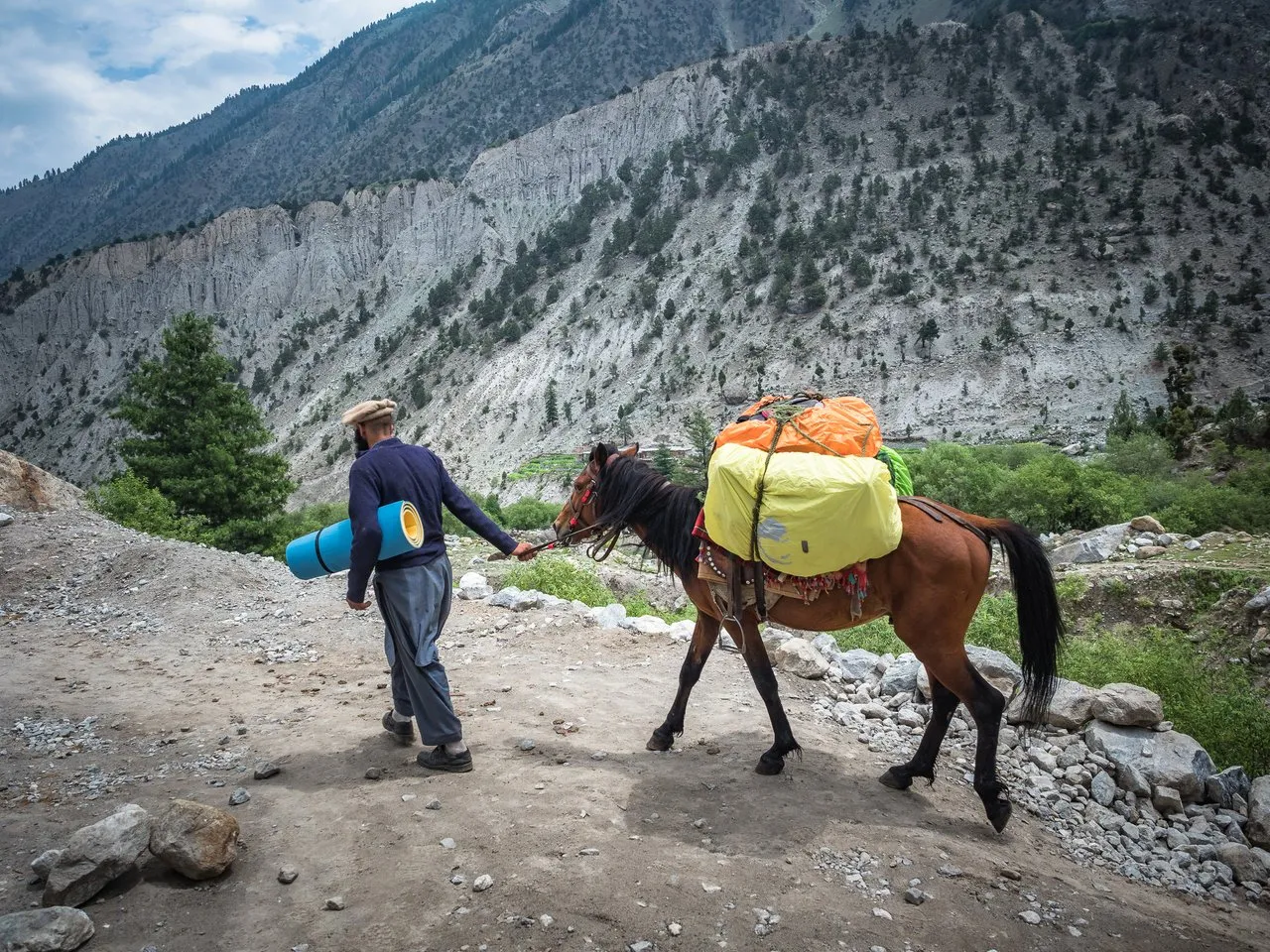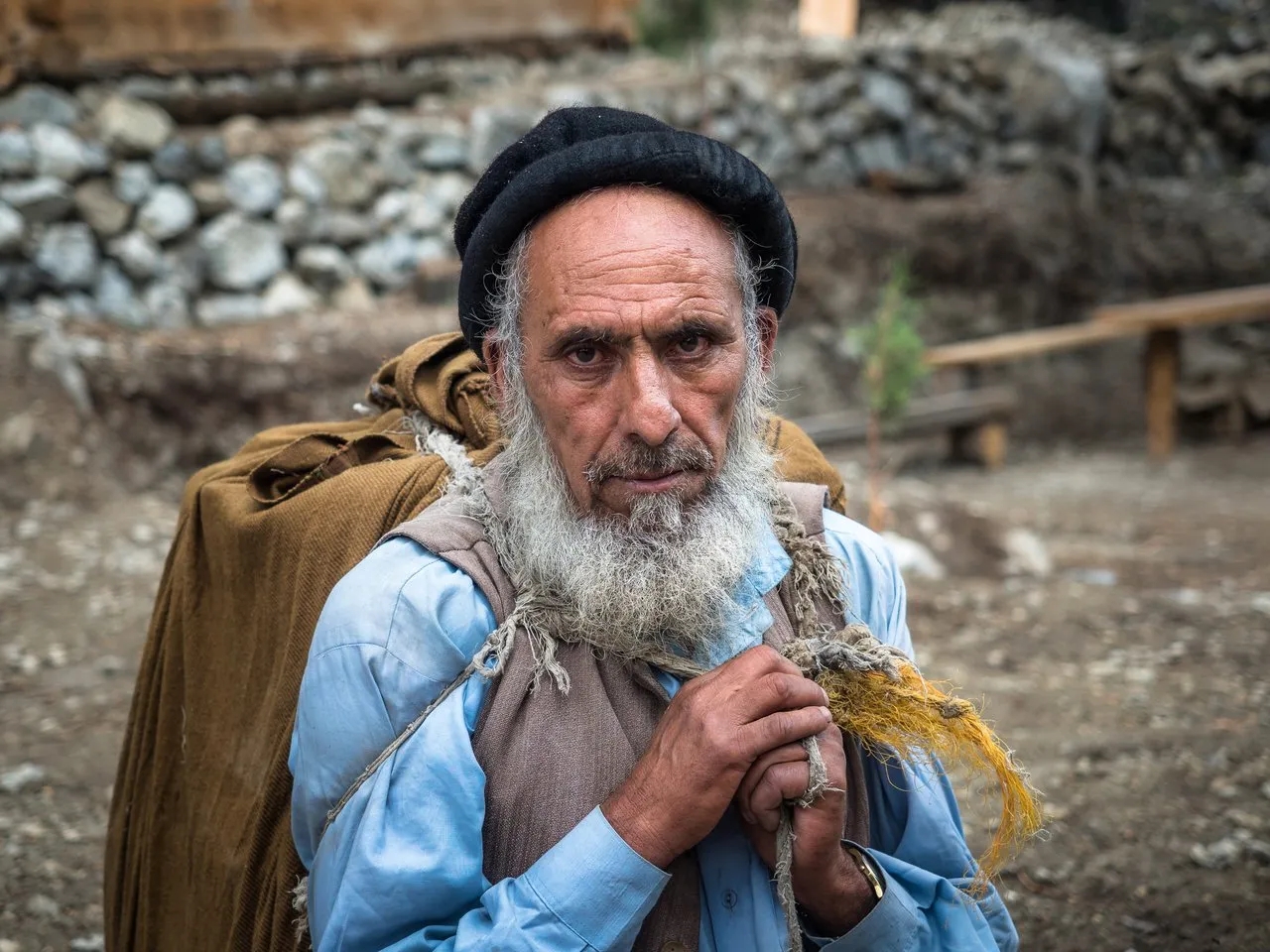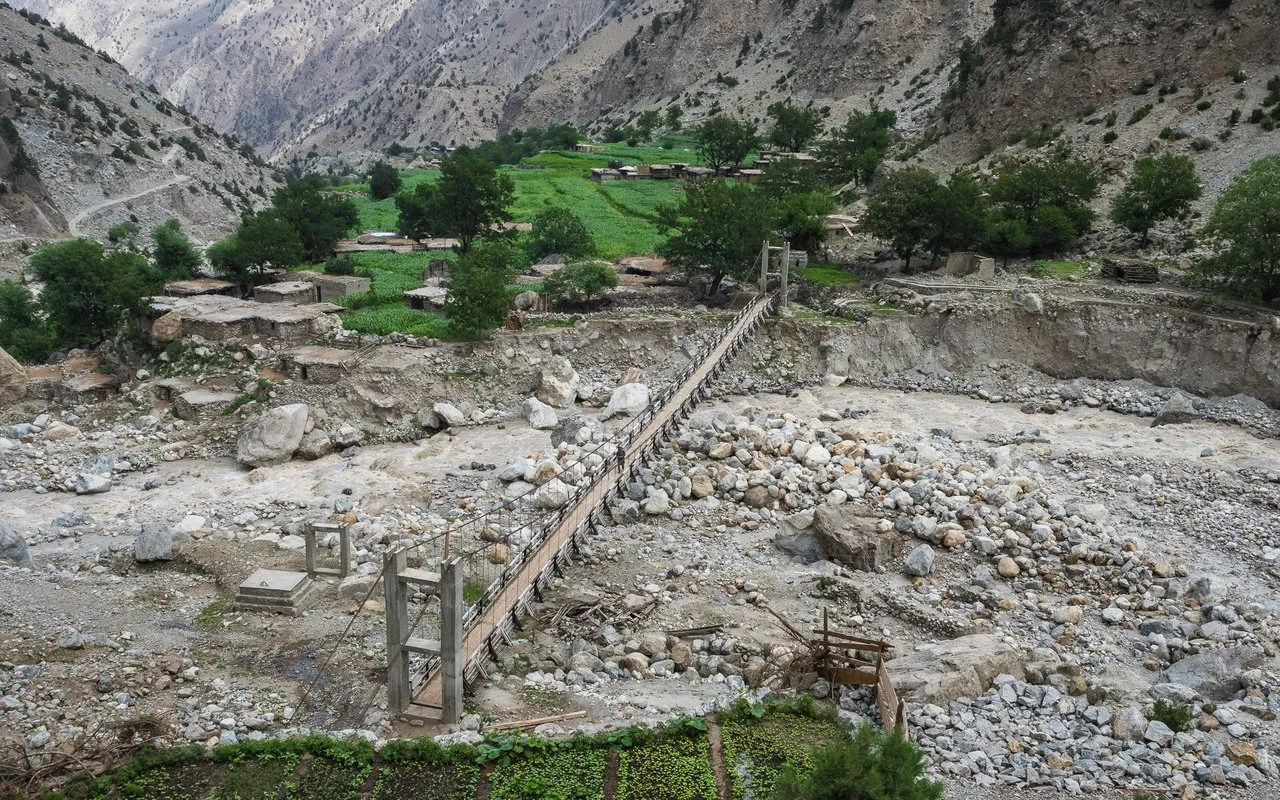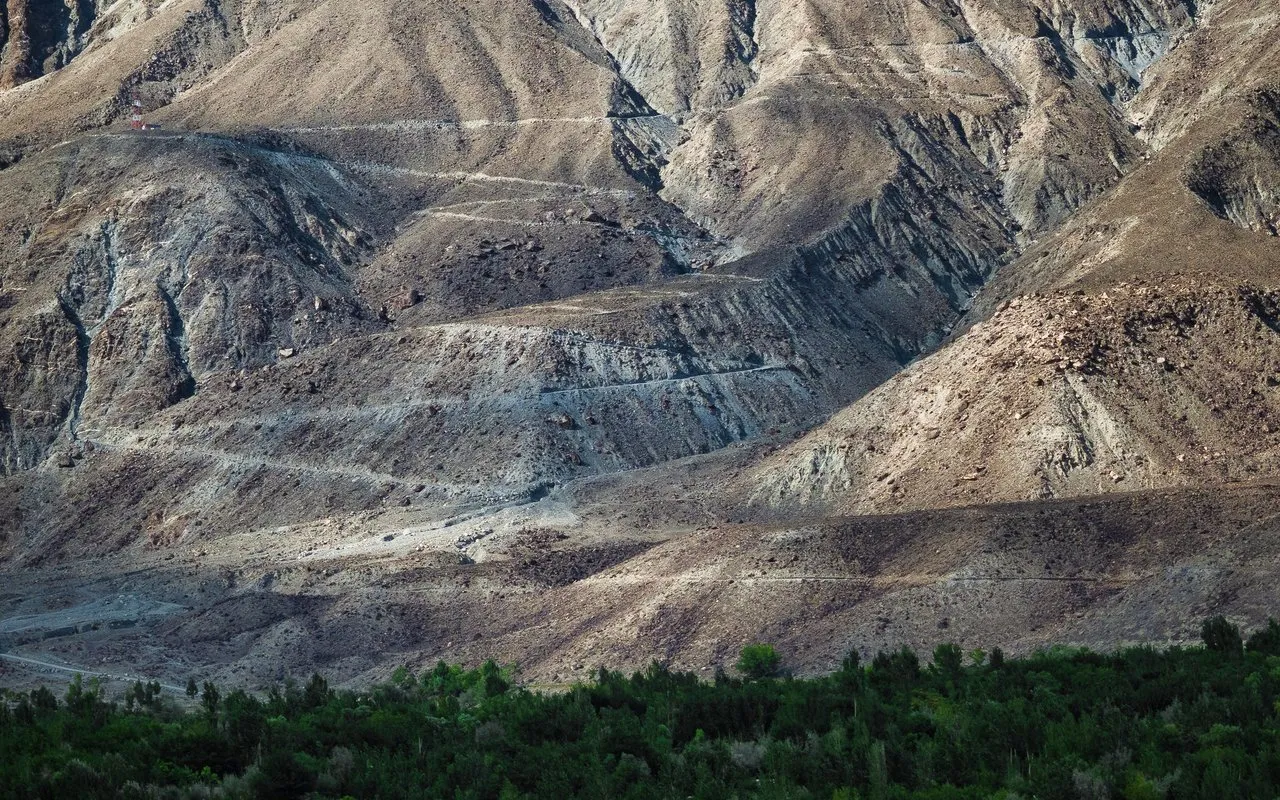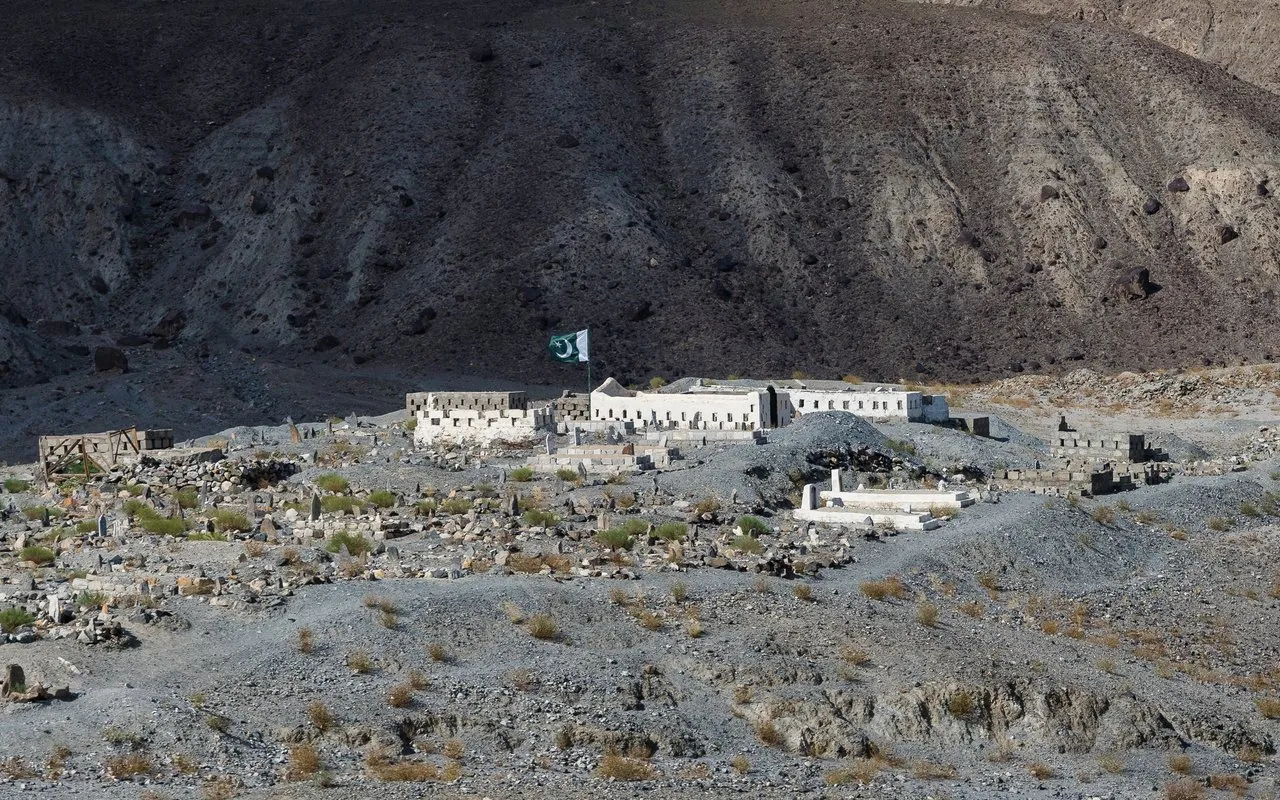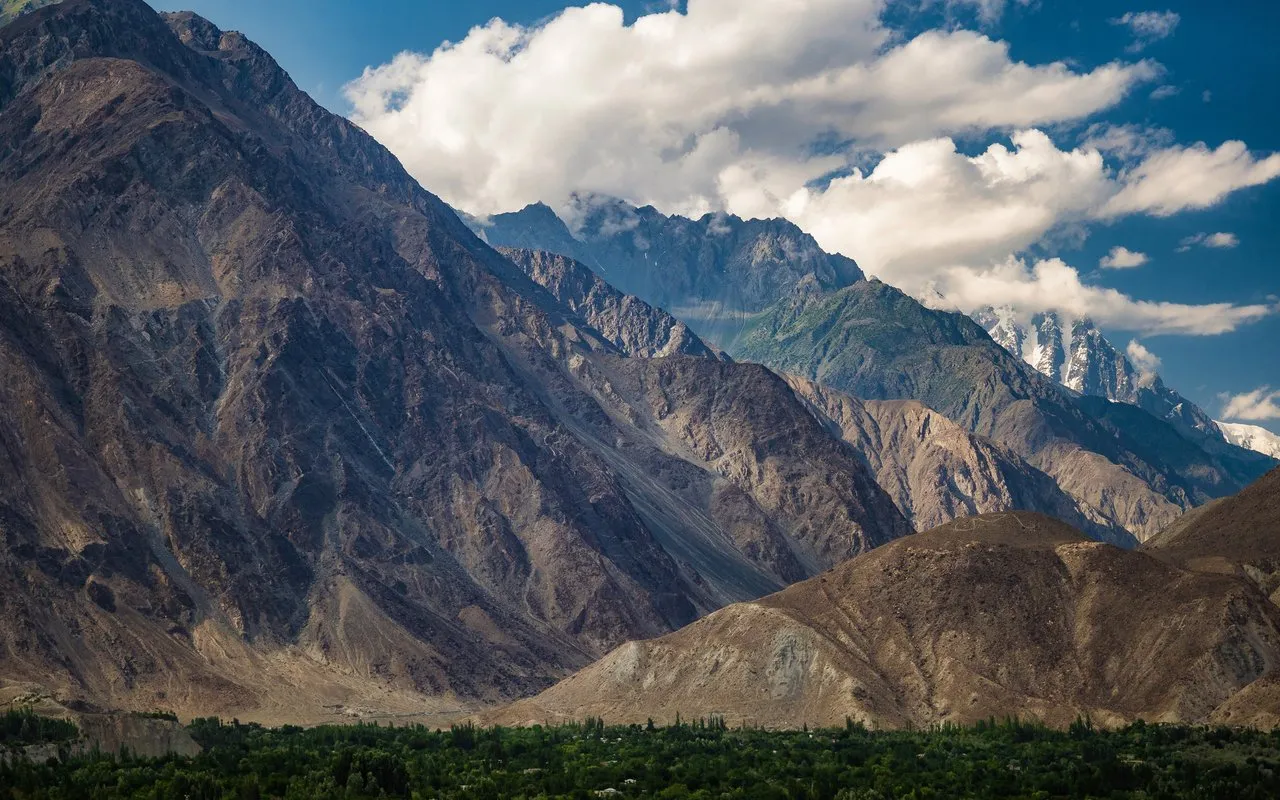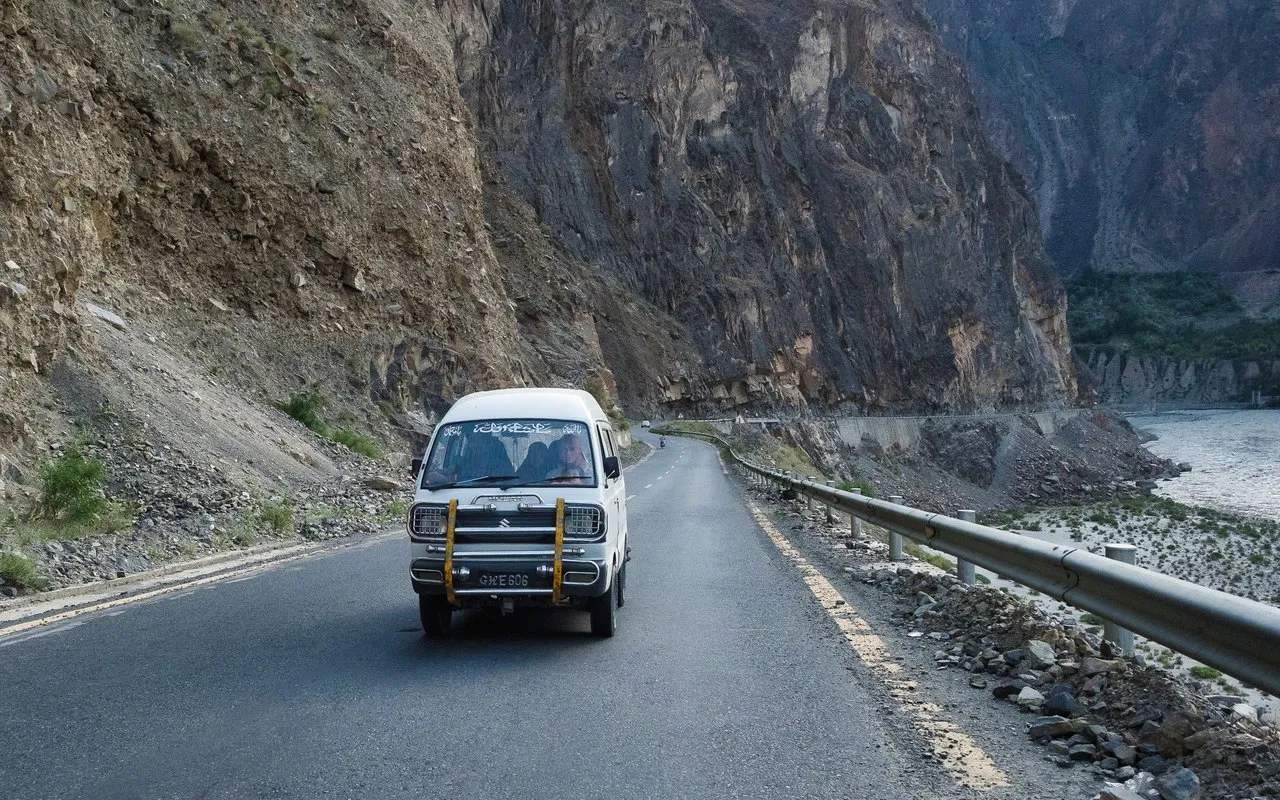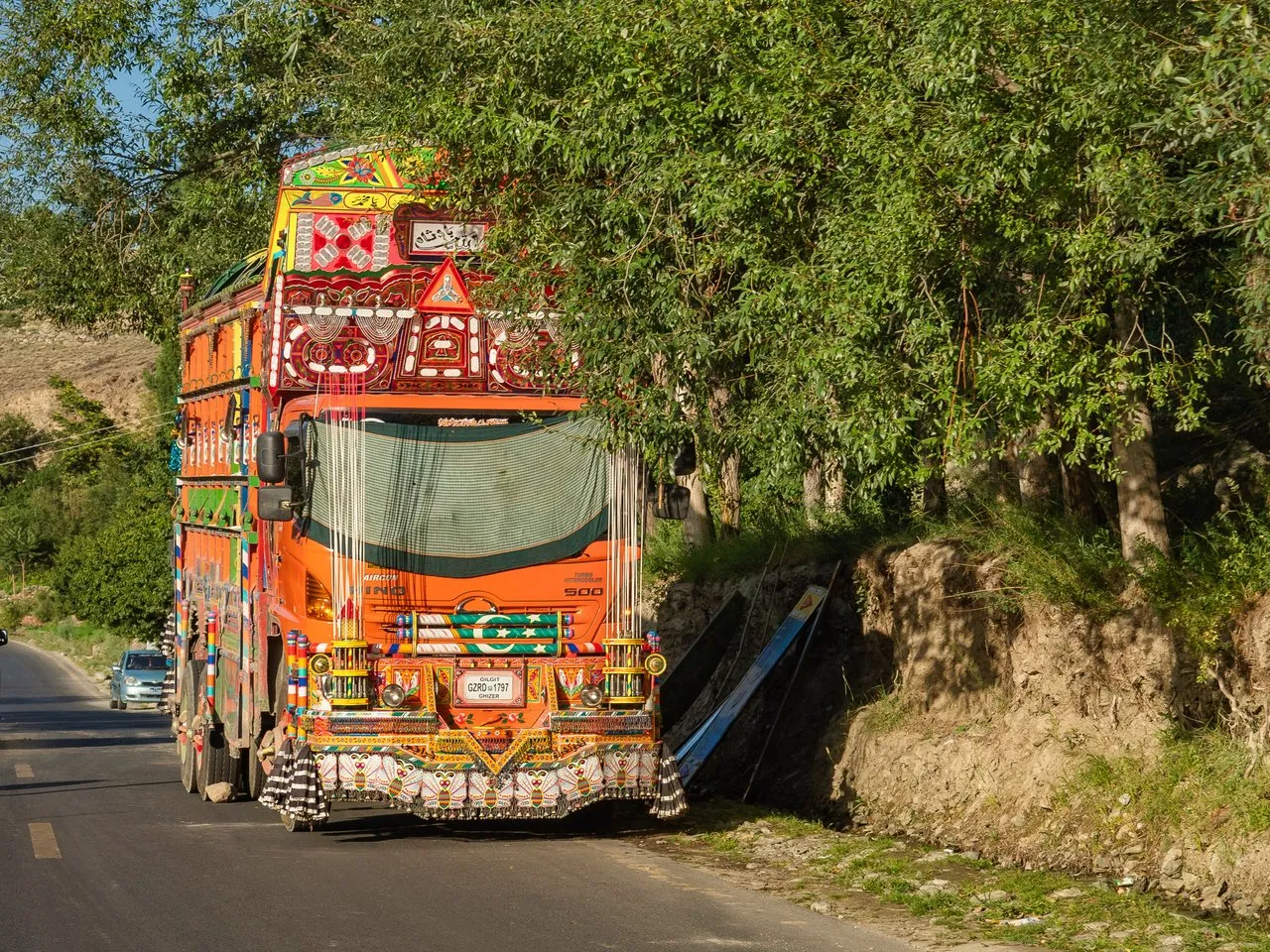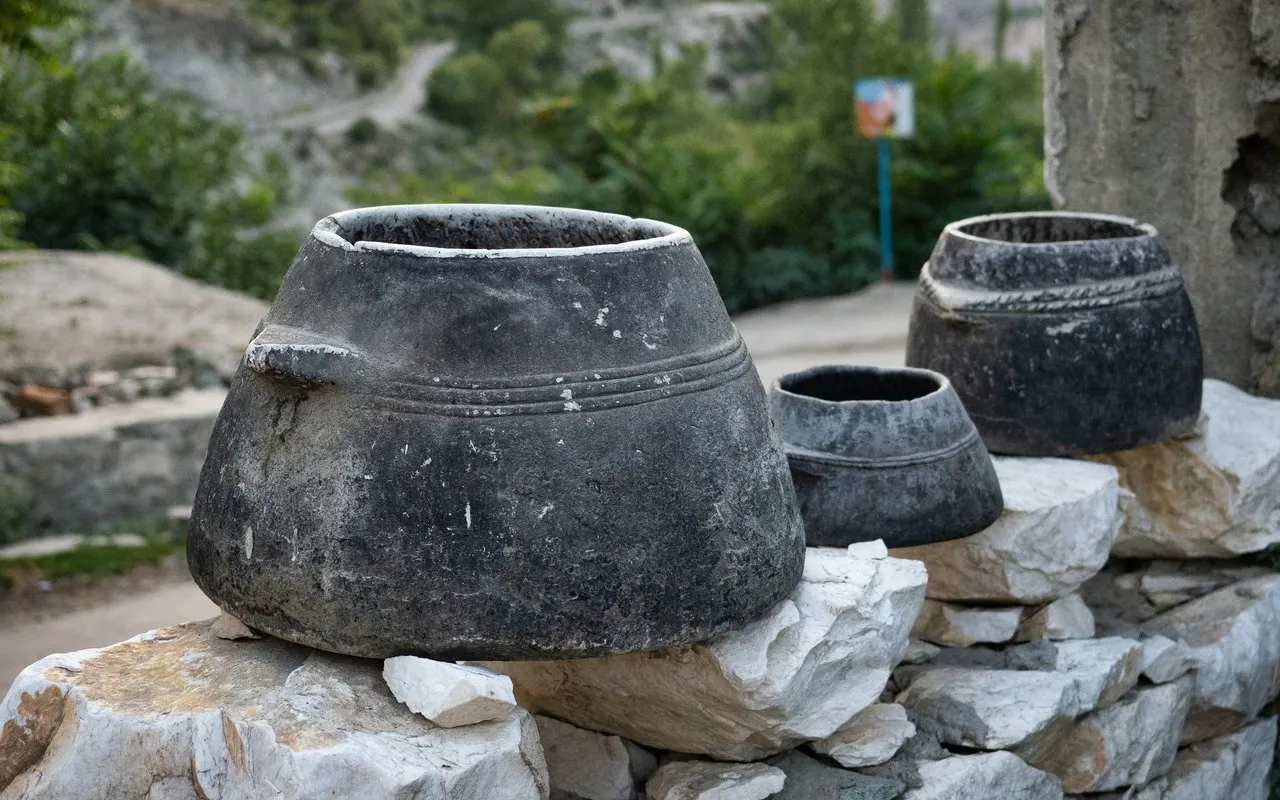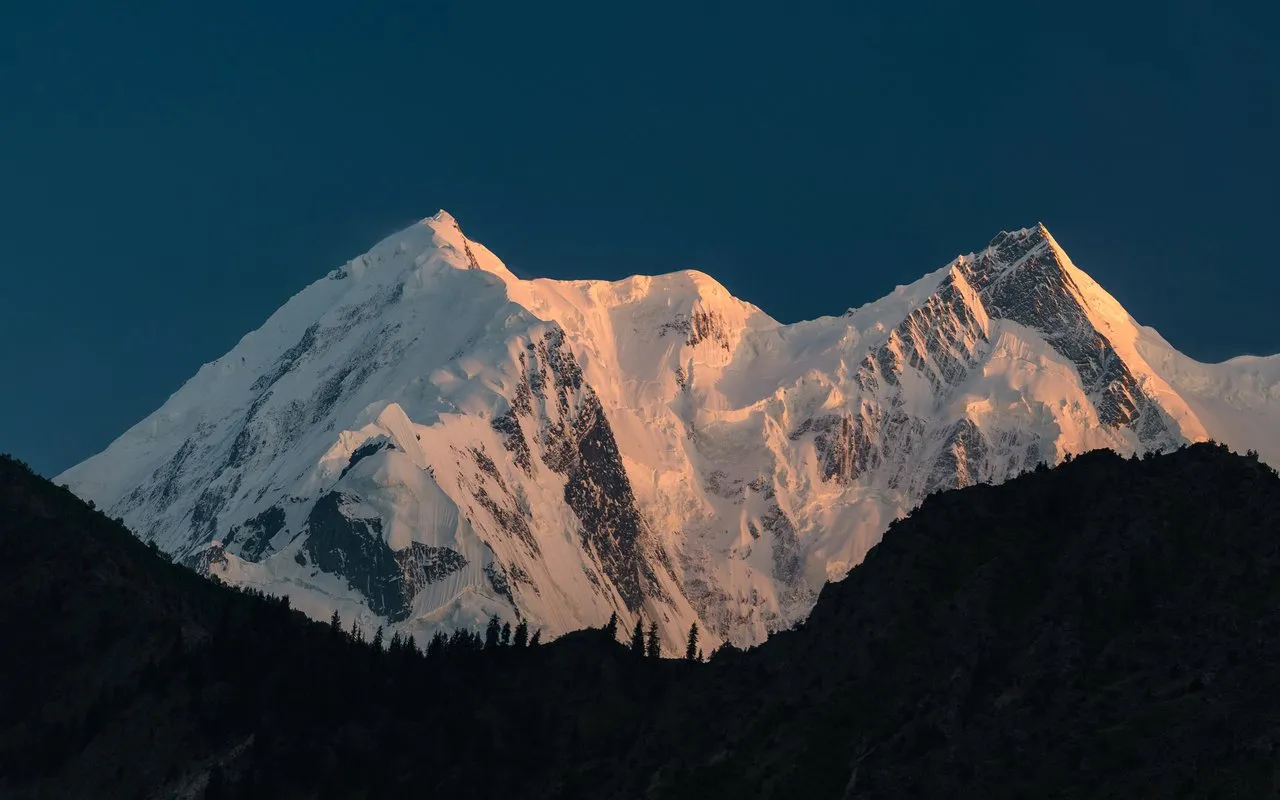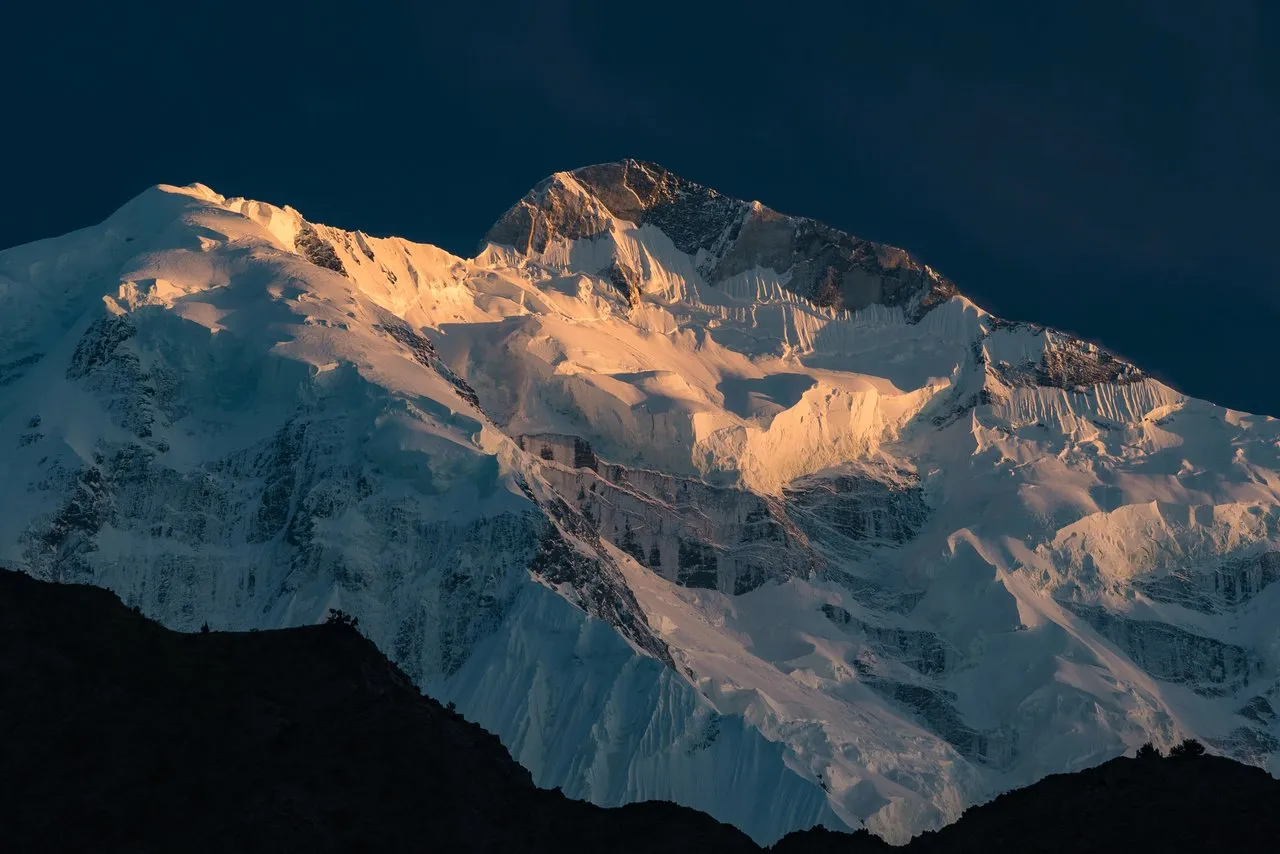Today we have a road down the same way as we went up to Fairy Meadows. It's easier to go down, and now we have already acclimatized. In any case, we do not breathe so hard, if we go up, and sleep well, although not enough. We got up again at 4 am to see the sunrise.
While preparing for shooting at the viewpoint near the tree, I turned very awkwardly and hurt my ear on a sticking tree branch. It hurts, blood flows — well, beautiful landscapes require sacrifice :) Now I have to hide my baseball cap and walk in a buff that will cover my ear from dust.
For two days I wanted clouds over the top of Nanga Parbat at dawn, and now, just before leaving here, my wish came true. The rising sun painted the sky pink and orange.
And soon the clouds covered the whole sky, it began to rain. It seems that here we need to be careful with desires, they tend to come true too much. We slept for an hour after dawn, and it was time to get ready for the return trip. We plan to change one mountain system to another in one day: from the Himalayas to the Karakoram.
Porters weigh our backpacks to make sure that there is no overload from the previously agreed maximum weight: in this sense, everything here is like on an airplane — if the backpack weighs more, then, of course, it will still be carried, but you will have to pay extra for each extra kilogram. Someone with a lot of things even had to shove some of their excess weights into another backpacks which weighed less than the norm. Then the porters load everything onto horses and donkeys or carry them on their own.
It’s good that the rain is almost over by the time we leave, it’s not wet, but pleasantly cool. The sun sometimes peeps out from behind the clouds, drying out the earth.
Seeing the weather, everyone put on the covers on their backpacks when packing, so that the possible rain would not get them wet. We went first, before the porters, but soon our backpacks caught up with us. Haha, my backpack is back up and the covers is on the bottom. If it rained again, I would get a small pool in which things would swim :)
Porters walk along the path in both directions. Some carry groceries, chairs, and building materials upstairs to the campsites. There is no other way to deliver anything there.
Their helpers, donkeys, are very hardy, they walk calmly with great weight.
And we all go light, except perhaps with trekking poles and small backpacks, where are the most necessary things that may be needed along the way.
There is enough water in the vicinity of the trail. But not entirely drinkable: in the local streams, which then flow into the Rakhiot River, the water is very dirty, we can't even believe that it is glacial. As soon as we look at this brown color, the desire to drink it disappears .
The descent took about an hour and a half. We reached it and did not even notice, it is not like the rise three days ago. Almost near the jeeps we saw that the trail collapsed and in its place were planks. We need to go very carefully along these, they are not installed very reliably, and I don't want to fly down :)
We wait for all the people and luggage, and then we start loading the jeeps. We are driving again with the same driver, a very cheerful and determined old man, he goes first in our small column.
Now we are in a normal condition, not after the flight, and we see all the way, I even manage to photograph something right on the go from the window, since there is no such thing as glass in the window openings of the doors in the current design of the car.
It is amazing that this road is laid out by hand with stones without any cementing mortar. The stones are simply stacked one by one on the slope to form a narrow horizontal strip — and now, the road is ready!
Scary beautiful — a very accurate definition of this section of our trip. The rocks are very beautiful! And the ride is very scary, sometimes it seems that the wheels on the starboard side are now just hanging over the abyss. However, they still always remained on the road, even if in some places at its very edge.
Below we see the old path, already falling apart in places and beginning to overgrow with grass. For some reason, they no longer use it.
In some places such terrible teeth stick out. But they are certainly excellent landmarks.
Many turns, by the way, are absolutely blind and at the same time quite steep. In combination with the narrowness of the road, it is understandable why almost every such driver gave a signal with a horn: the oncoming car could not be seen earlier than a dozen centimeters from the hood, and if someone was driving towards, let him slow down and try to give way. After all, at the turn, two cars do not miss, and someone can fly down, or at least both cars will be badly crushed.
Upon returning home, when I started writing posts, I learned that this road is considered one of the most dangerous roads in the world. Not that it was some kind of official list, but often in such lists as "10 most ... things" it appears in one place or another (example and one more). At the same time, the views around are quite picturesque — the mountains are always beautiful. I'm not sure that I am able to convey all the acuteness of sensations in the photographs :) How do you say, did I manage to convey the atmosphere of the road?
As I have noticed, the attitude towards safety for humans in Pakistan is, in principle, a little different from we have. I do not want to say anything bad, of course, I am for the maximum preservation of nature in the wild and minimum human intervention.
At the end of the path, all things and ourselves are covered in dust, and there is also a strong and hot wind. I never thought it could be so hot in the mountains.
The plain below is strewn with huge stones, and among them our road continues to curl.
At the very bottom, at the end point of the jeep road, the wind picks up and seems to turn into a sandstorm. We loaded our backpacks onto the roof of the minibus and started off. It's hot and stuffy, it's a long way to go.
On the way, in many places on the slopes, inscriptions are often found, laid out with white-painted stones. Some designate places, some greet guests or glorify religious leaders. Locals lay them out and constantly renew on crumbling slopes.
In some places, I would not want to go up at all — there even the paths are not visible, as if people flew up to them on their wings!
We stopped to buy a mango — I did not expect to see this fruit in Pakistan, but it (or juice from it) accompanied us almost the entire trip. And there are also melons, watermelons, apricots. But mangoes are delicious! You cannot find such mangoes in Russia. The main thing is not to forget to wash this fruit and berry abundance and hope for the strength of the stomach :)
How Pakistanis love to be photographed! They start posing without any problems and calmly wait until you finish shooting.
Well, I'll use the stop to take pictures of town life and people.
Some people are shy about taking pictures on the streets. And I think that if you are shooting a person from close range, in portrait, then you can nod at the camera and ask permission. If they are not agree, they will tell you about it. And if from afar, as a part of the life around you — well, now everyone walk around with smartphones and shoot everything and anytime, and the person caught in the shot is just part of a scene from the life of the city. In any case, if a person doesn't like it or if it's forbidden to take a pictures there, they will tell you this explicitly.
On the shelves of street shops, I saw some kind of dessert. I wanted to buy one piece, just to try it. One of the sellers said — 200 rupees, and the other take and gave it for free. It is something like thin fried rolls with syrup inside and outside, very sweet.
Livestock is often transported in cars — in trunks and on roofs. People are transported in much the same way. And sometimes they stand on all sides right on the steps of the car, when there is no more space inside.
In general, this is how many street shops look like, and there are refrigerators with juices and soda, which we constantly emptied. Even those who don't like it very much drank mango nectar — for some reason there is an obvious deficit with other juices, and few of us are fan of sweet soda.
Pakistani trucks, like donkeys, carry just a huge weight, which, in my opinion, they are not designed for. However, they seem to be doing it.
Shoemaker's street workshop. Hanging rags are leather and other materials used to make shoes. It would be interesting to order not factory, but real handmade shoes, but this takes time.
So, we made all the necessary purchases and move on. Along the way, new landscapes are constantly opening up, if we want to stop at each one, it's easier to walk :)
There were very few photo stops on this trip. Still, getting out of a minibus is more difficult and longer than getting out of a jeep. However, the minibus also has windows from which we can try to shoot something on the road)
There is no shortage of scenic views.
"Quite a long road through the populated areas is almost behind, but so far we have not seen a single cemetery," I thought, looking out the window. At the next turn I see this picture. Another wish that came true right away. No, this is not an unfinished complex of buildings, as one might think, it is a cemetery I expected.
Very different rocks in one place, loose, green and snowy, sweep past in a kaleidoscope.
By the way, I noticed that here (I mean the Gilgit-Baltistan region, several towns and villages that we visited), both in towns and outside of them, buildings are often built and left just gray, not painted in any color, not decorated, except perhaps minimal. Of course, I do not mean by decoration numerous bright colored signs over shops, and other billboards, which, on the contrary, are often flashy and colorful.
Perhaps the eye-pleasing decorative exterior of buildings is considered unnecessary, or often there is not enough money for it. As a result, houses often blend in with the surrounding landscape, especially if the background is gray-brown mountains.
On the way, we periodically come across roadblocks, where Pakistani police rewrite passport data into huge registration books. We gladly give away printed copies of passports.
Sometimes our minibus is passed without stopping and checking. But once we ourselves drove past one without stopping, apparently, the driver was thinking about something. A few minutes later, a police officer on a motorcycle caught up with us, forced us to huddle to the side of the road, shouted, waved his arms and sent us back to the roadblock.
Sometimes, along the way, there are different buildings in an empty... I would like to say - a field, but no. In a empty, barren, rocky desert in the foothills — this is probably more correct. There is nothing around, but they stand alone on the dais. And even behind solid fences.
But of course, it is far from being so severe everywhere. There are also cheerful, green cliffs and slopes with trees, bushes and grass.
One of the level 80 gear trucks we met along the way. How bright and beautiful it is! Now I look with particular sadness at the trucks on our roads — they are so boring.
Our journey is coming to an end for today. A photo stop at the view point of Mount Rakaposhi. Its height is quite easy to remember — 7788 meters. This is Karakoram, so we got to it.
There are many cafes and teahouses near the lookout near the river, where it seems that all the seats are already taken. And the view is worth it.
We arrived at the Minapin village (2050m above sea level). Some Pakistanis before us had checked into the hotel where we planned to spend the night and the owner, as he said, would not evict them. It's strange, after all, we booked housing here in advance. Well, okay, they are looking for new housing for us, and while we wait, we drink tea with rose petals and eat apricots in the garden of a small hotel overlooking the snow-capped peak of Mount Rakaposhi.
As a result, pretty soon everything were solved: we go to the Diran guest house — the best in Minapin, as we were told. In any case, the view to the mountain is definitely better here, and there are also delicious apples on the territory that we can pick and eat right from the trees.
And it is convenient to admire the evening mountains: there is a patio without a roof, so we can go out the door of your room, sit on a bench and look into the sky at the mountains, and then at the stars.
We talked a little with one of the guesthouse workers while waiting for check-in. It turns out that Pakistanis know much more about Russia than we do about Pakistan, they even watch some events in our country. Well, at least some Pakistanis do that.
For dinner we were fed with delicious spicy and sour Chinese chicken soup, salad and stew of goat meat. It was incredibly tasty, especially considering that at the high altitude in the mountains, meat is not eaten — we were told that it is bad for digestion. Only chicken is sometimes eaten, and that is usually even lower in height than we were at Fairy Meadows. And we managed to miss meat very much, I did not expect a vegetarian diet where we need strength for walking and trekking.
Tomorrow we are going to the base camp of Mount Rakaposhi — the very mountain that we are admiring now, where we will camp for two nights. Hooray, new snow-capped mountains await us! :) We walked in the Himalayas, now we will walk along the Karakoram. This means that we need to pack all the essentials in backpacks, and we were asked to leave the unnecessary here until we return, so that it would be easier for the porters to carry. And, of course, we need to sleep well. I think this time, before the day of trekking in the mountains, I’d better sleep a little more so that tomorrow it’s not so hard to climb.
To be continued...
Parts of the journey:
- The Land of High Mountains: Pakistan. Day 1. Arrival and Transfer to the Mountains
- The Land of High Mountains: Pakistan. Day 1. Trekking to Fairy Meadows
- The Land of High Mountains: Pakistan. Day 2. Acclimatization
- The Land of High Mountains: Pakistan. Day 3. Trekking to Nanga Parbat Base Camp - Start
- The Land of High Mountains: Pakistan. Day 3. Trekking to Nanga Parbat Base Camp - Finish
- The Land of High Mountains: Pakistan. Day 4. From the Himalayas to the Karakoram
- The Land of High Mountains: Pakistan. Day 5. The road to Mount Rakaposhi - Hakapun or further?
- The Land of High Mountains: Pakistan. Day 5. The road to Mount Rakaposhi - Base Camp
- The Land of High Mountains: Pakistan. Day 6. Minapin Glacier and Ice Bridge
- The Land of High Mountains: Pakistan. Day 7. How to Get to the Eagle's Nest?
- The Land of High Mountains: Pakistan. Day 8. Hike to Ladyfinger Peak
- The Land of High Mountains: Pakistan. Day 8. Walk in Karimabad to Altit and Baltit Forts
- The Land of High Mountains: Pakistan. Day 9. Karimabad and the Sacred Rocks of Hunza
- The Land of High Mountains: Pakistan. Day 9. Attabad Lake, Hussaini Bridge and Passu Cathedral
- The Land of High Mountains: Pakistan. Day 10. Crossing the Batura Glacier: the Beginning
- The Land of High Mountains: Pakistan. Day 10. Crossing the Batura Glacier: Finish
Camera: OLYMPUS E-M1 Mark II
It's better to watch the photos in high resolution — just click on them and open in a new window.
You can also see my photos in my blog LJ and in my profile on NatGeo

By the way, if you are interested in purchasing my high-resolution photographs in order to use them privately (including printing on photo paper or large canvas), create a collection of limited editions of digital pictures you own or just thank me for my work, you can visit the new Lensy.io marketplace and view and buy one of limited editions of my tokenized photos. Lensy.io is a digital photography marketplace built on the Hive blockchain.
You can also feel free to write me and ask any photo you like from my blog to add there for the purpose of further purchase.





